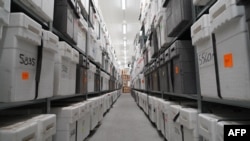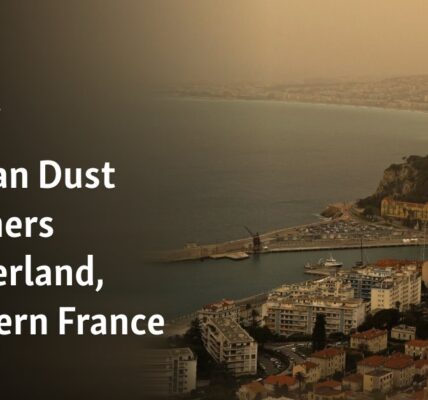How was the air breathed by Caesar, the Prophet Mohammed or Christopher Columbus? A giant freezer in Copenhagen holds the answers, storing blocks of ice with atmospheric tales thousands of years old.
The collection known as the Ice Core Archive contains 25 kilometers (15 miles) of ice, mostly gathered from Greenland, and is aiding scientists in comprehending shifts in the Earth’s climate.
According to glaciology professor Jorgen Peder Steffensen from the University of Copenhagen, this archive contains evidence of prehistoric climate change and documents mankind’s actions over the past 10,000 years.
For 43 years, his love for ice blocks has been unwavering. It was during his exploration of Greenland’s ice sheet that he crossed paths with his wife, Dorthe Dahl-Jensen, a renowned specialist in paleoclimatology.
Since 1991, Steffensen has overseen the management of the repository, which is one of the largest in the world. The repository contains 40,000 blocks of ice that are stored on long rows of shelves in large boxes.
The frozen samples are unique, made up of compressed snow and not frozen water.
Steffensen clarified that the air enclosed within the bubbles formed between the snowflakes is equal in age to the ice.
The antechamber of the repository functions like the reading room of a library. It is where scientists can analyze the ice they have retrieved from the main storage area, similar to checking out books from a library.
However, they need to act fast as the antechamber’s temperature is maintained at -18 degrees Celsius (-0.4F), which is significantly warmer than the storage room’s temperature of -30C (-22F).
Steffensen is taking out a chunk of ice from a container. The air bubbles can be seen without any equipment and it is snow that accumulated in the winter of the first year.
Steffensen, wearing a cozy winter hat with fuzzy ear flaps, excitedly talks about the Christmas decorations and the genuine snow of the season.
Bedrock
In the 1960s, a group of scientists transported the initial ice cores to Denmark from Camp Century, a confidential American military installation located in Greenland.
The most recent instances occurred during the summer season, when researchers reached the bottom layer of eastern Greenland at a depth of 2.6 kilometers, collecting the most ancient ice available.
The samples include remnants from 120,000 years ago, from the last interglacial period when Greenland’s air temperatures were 5C warmer compared to current temperatures.
According to Steffensen, the earth was significantly warmer in the past before the presence of humans.
The recently obtained ice is expected to aid in scientists’ comprehension of the increasing sea levels, which can only be partially accounted for by the diminishing ice cap.
The cause of this phenomenon is also attributed to ice streams, which are rapidly moving sections of the ice sheet that are melting at a concerning rate.
Steffensen stated that by improving our understanding of the ice streams, we will be able to estimate the extent of the contribution from Greenland and Antarctica to the future rise in sea levels.
He is optimistic that they will be able to accurately forecast a 15 centimeter margin of error for sea level rise in 100 years, which is a significant improvement from the current 70 centimeter margin of error.
‘Treasure’
Ice cores are the sole method of determining the state of the atmosphere before human-induced pollution.
Steffensen stated that through the use of ice cores, we have charted the fluctuations of greenhouse gases, specifically carbon dioxide and methane, throughout history.
“We can observe the consequences of burning fossil fuels in present-day society.”
This particular project is distinct from the Ice Memory organization. The foundation has gathered ice samples from 20 different locations around the world and is storing them at the French-Italian Concordia research station in Antarctica. This is being done in order to ensure that the ice cores are available for future scientists to study, as they are at risk of disappearing permanently due to the effects of climate change.
The director of the foundation, Jerome Chappellaz, expressed that preserving the ice memory of Greenland is highly beneficial.
However, he pointed out that storing samples in a commercial freezer can be vulnerable to technical issues, financial challenges, attacks, or conflict.
In 2017, a malfunctioning freezer at the University of Alberta in Canada resulted in 13% of its valuable samples, which were thousands of years old, being exposed to higher than desired temperatures.
The average yearly temperature at Concordia Station is -55C, creating ideal storage conditions for future centuries.
Chappellaz urged the Danes to participate in Concordia’s project, stating that they have a valuable treasure.
“We have a responsibility to safeguard this valuable treasure and strive to include it in humanity’s world heritage.”
Source: voanews.com




